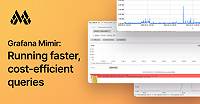Visualize native histograms
Prometheus native histograms are a data type in the Prometheus ecosystem that allow you to produce, store, and query a high-resolution histogram of observations. To learn more about the native histograms data type and how to start sending native histograms to Grafana Mimir, refer to Send native histograms to Mimir.
Note
Not all visualizations support the native histogram data type. However, you can use the Prometheus Query Language (PromQL) to derive the floating point time series from a native histogram, and then use this series in a visualization.
Prometheus Query Language
Use the Prometheus Query Language (PromQL) to query native histogram metrics. The data type of your query results depends on the query and the underlying data.
For more information about PromQL, refer to Querying Prometheus.
The following examples show common ways to derive floating point data type from native histograms data for visualizations and also how to convert existing queries using classic histograms into queries using native histograms.
Note that the native histogram queries do not include the _bucket, _sum and _count suffixes of classic histograms.
For more information on native histogram flavors and how to query them using PromQL, refer to the Prometheus Native Histograms specification.
Query your histogram’s count or sum
To query the total count of observations within a histogram, use the following queries:
# Native histograms:
sum(histogram_count(request_duration_seconds))
# Classic histograms:
sum(request_duration_seconds_count)To query the total sum of observed values, use the following query:
# Native histograms:
sum(histogram_sum(request_duration_seconds))
# Classic histograms:
sum(request_duration_seconds_sum)Note
sum(histogram_count(request_duration_seconds))andhistogram_count(sum(request_duration_seconds))are equivalent in terms of query results, but the former is more efficient. This applies tosumwithhistogram_sumas well.
Find rate of observations
To query the rate of all observations calculated over 5 minute time window, use the following query:
# Native histograms:
sum(histogram_count(rate(request_duration_seconds[5m])))
# Classic histograms:
sum(rate(request_duration_seconds_count[5m]))To query the rate of observations between two values such as 0 and 2 seconds, use the following query:
# Native histograms:
histogram_fraction(0, 2, sum(rate(request_duration_seconds[5m])))
*
sum(histogram_count(rate(request_duration_seconds[5m])))
# Classic histograms:
sum(rate(request_duration_seconds_bucket{le="2.5"}[5m]))There is a native histogram function that estimates the fraction of the total number of observations that fall within a certain interval, such as [0, 2].
For more information, refer to histogram fraction.
Classic histograms have no such function. Therefore, if the lower and upper bounds of the interval do not line up with the bucket boundaries of a classic histogram, you have to estimate the fraction manually.
Note
Only ever use the
histogram_fractionfunction by includingrateorincreaseinside of it with a suitable range selector. If you do not specify a range, such as5m, the function uses the current value of the histogram. In that case, the current value is an accumulated value over the lifespan of the histogram or since the histogram was last reset.
Quantiles
To query an upper bound of observation values that 95% of observations fall under, use the following query:
# Native histograms:
histogram_quantile(0.95, sum(rate(request_duration_seconds[5m])))
# Classic histograms:
histogram_quantile(0.95, sum by (le) (rate(request_duration_seconds_bucket[5m])))Note
Only ever use the
histogram_quantilefunction by includingrateorincreaseinside of it with a suitable range selector. If you do not specify a range, such as5m, the function uses the current value of the histogram. In that case, the current value is an accumulated value over the lifespan of the histogram or since the histogram was last reset.
Create Grafana dashboards
The panel types Histogram and Heatmap are compatible with the native histogram data type. Use these panel types to visualize a query, such as:
sum(rate(request_duration_seconds[$__rate_interval]))For all other panel types, for example Timeseries, use one of the histogram functions in the Prometheus Query Language to visualize a derived float time series.
Grafana classic explore
In Explore, use one of the histogram functions in Prometheus Query Language to visualize a derived float time series.
Note
Visualizing native histogram data type directly without the histogram functions in the Explore view is not supported at this time.


